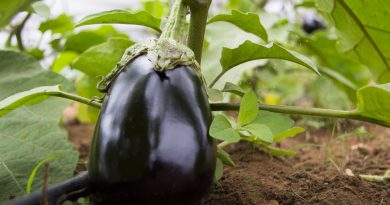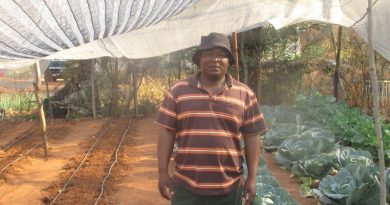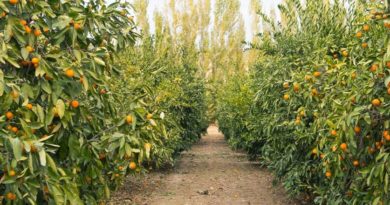Mushroom: Creating Room for Economic Opportunities
Neo Seate, director of the 30 hectare integrated Senela Farm, located on the outskirts of Serinane, a small settlement situated about 30km from Molepolole, has always loved mushrooms, especially traditional mushrooms (Mabowa),She once got lost while looking for them out in the bush as a little kid. Below is how her story goes.
Farmers Review: When and why did you start mushroom production?
Neo Seate: I have always loved to eat mushrooms especially traditional mushrooms (Mabowa). I recall an incident as a little girl when I got lost in the bush while looking for Mabowa. Years later, as a horticulture farmer, I have decided to get into mushrooms on top of other vegetables that I produce. The other reason I ventured into the business is that there is high demand for mushrooms locally. However, there are few local suppliers for the product.
FR: Where did you learn how to produce mushrooms?
NS: I did a short mushroom training workshop with Botswana University of Agriculture and Natural Resources (BUAN) to sharpen my skills in the sector.
FR: How big is your operation?
NS: I have just started although I have been trying since August 2017.
FR: Which investments have you made since you started the business?
NS: Now that I have successfully managed to produce I have just started to build a mushroom house, which will come handy for me in the future.
FR: What kind of mushrooms do you grow and why?
NS: I am growing Oyster mushrooms mainly because they are the easiest to grow and high yielding. Furthermore, it takes quite a short period of time before they mature as compared to others. These types of mushrooms can be grown in-house. To top it all, these mushrooms are nutritious, tasty, visually appealing, and most importantly easy to grow.
FR: Explain to us the step by step process of growing mushrooms?
NS: Oyster mushrooms grow in a wide variety of substrates and the production process for oyster mushrooms, from cloning to harvesting, takes about 75 days. However it can take less if ready to use spawns are used. I get ready to use spawn from BUAN lab.
I first cut the maize straws with a fodder machine I then pasteurise the straws my steaming it for 2 hours to remove any bacteria, the substrate is then cooled at room temperature ready to be mixed with spawns and put in transparent plastic bags. Once inoculated, the bags should be left to incubate. During this time the spawn “runs” (mycelium spreads) throughout the straw. The spawn run will be complete when the mycelium has spread entirely throughout the bag (the straw is then fully colonized). Finally, as the bags become fully colonized, the initial stages of fruiting (or pinning) may be seen. The pins take 1-4 days to be ready for harvest.
FR: How long does it take before they are ready for the market?
NS: It takes about 75-90 days which can be more or less depending on the variety of the mushroom used as some grows faster than others. If ready to use spawn is used the production period can be reduced to 20-30 days from the day of planting in the bags to harvesting.
FR: What equipment or farm implements are needed for mushroom farming?
NS: Mushrooms need a sterile environment where temperature and humidity can be controlled. For oysters they can be grown both indoors and outdoors.
FR: What hygienic conditions are of essence when growing mushrooms?
NS: Hygiene is very important as mushrooms spawns can get easily contaminated. The equipment used should be sterilised and proper personal protective clothing worn e.g. rubber gloves, hair net, overall and face mask. Daily inspections should be made on growing bags to check any signs of contamination and spawn or contaminated bags should be thrown away,
FR: Are they any pests or diseases that attack mushrooms?
NS: A variety of small fly and midge species are pests of mushrooms. The larvae feed on the fungal mycelium in the compost, but may also tunnel into the fruiting bodies. A range of mite species may affect the mushroom crop. Some directly damage the fruiting bodies, some may attack the mycelium and some mites are predatory on other mites, fly eggs, nematodes or bacteria. Mite damage on the fruiting bodies often shows up as small cavities in the stem and cap similar in appearance to bacterial pit disease. Mycelium-eating mites can cause high yield losses. Mites are very small and easily transported on clothing and tools. Even though the mushroom itself is a fungus, it can in turn be affected by a range of fungal pathogens as well as bacterial diseases. Maintaining high levels of hygiene will assist any pest management program by reducing the number of problems that are likely to occur.
FR: What challenges do you face in mushroom production?
NS: Although it may look easier, there is hard work involved in growing mushrooms. You need to be passionate. Mushrooms require a completely sterile environment and this poses a challenge as they get easily contaminated. Weather or climatic conditions are also a huge challenge. Farming is a risky business. Some say it’s a profession of hope.
FR: Who are your customers?
NS: At the moment I am supplying individuals as my production is still small. I hope to increase production after building a proper mushroom house.
Have you been recognised for your efforts in the country’s agricultural business?
I was named the ‘Young Female Farmer of the Year’ in the inaugural Botswana Farming awards which were held last year. The award has since motivated her to do more, empower others and encourage them to work hard on their agribusiness enterprises.
FR: What’s your take on women in farming locally?
NS: Local women have always been involved in farming from time immemorial but in today’s society we, as women, tend to shun farming. By practising farming, I am trying to show other women that, it is a business worth doing and enjoying. Women and society in general associate farming with the poor and uneducated. My goal is to change that perception. Capacity building is also vital if women are to succeed in farming. Most women who want to venture into farming are passionate but some lack knowledge and skills therefore one of my objective and mission is to mentor aspiring women farmers.
FR: What advice can you say to those looking to start mushroom farming?
NS: As I have already stated, even though mushroom production might look easier, it needs outmost care, patience and dedication.
FR: What are your future plans regarding mushroom farming?
NS: I would love to increase my oyster mushroom production and to start producing button mushrooms as they are the most popular in the country. Ultimately I want to develop Senela farm into an agro-tourism business with all the necessary amenities and services.



